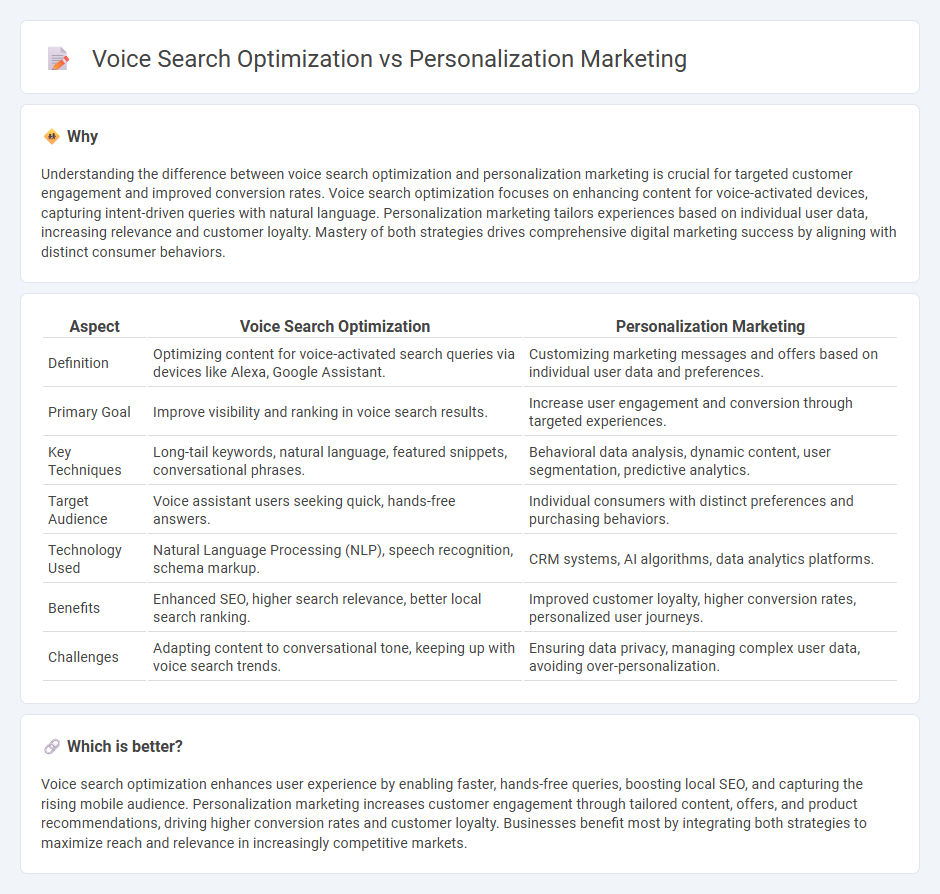
Voice search optimization enhances marketing strategies by targeting conversational queries and leveraging natural language processing to improve search visibility and customer engagement. Personalization marketing tailors content and offers based on individual customer data, increasing relevance and conversion rates through dynamic user experiences. Explore how integrating voice search optimization with personalized marketing can revolutionize your digital outreach.
Why it is important
Understanding the difference between voice search optimization and personalization marketing is crucial for targeted customer engagement and improved conversion rates. Voice search optimization focuses on enhancing content for voice-activated devices, capturing intent-driven queries with natural language. Personalization marketing tailors experiences based on individual user data, increasing relevance and customer loyalty. Mastery of both strategies drives comprehensive digital marketing success by aligning with distinct consumer behaviors.
Comparison Table
| Aspect | Voice Search Optimization | Personalization Marketing |
|---|---|---|
| Definition | Optimizing content for voice-activated search queries via devices like Alexa, Google Assistant. | Customizing marketing messages and offers based on individual user data and preferences. |
| Primary Goal | Improve visibility and ranking in voice search results. | Increase user engagement and conversion through targeted experiences. |
| Key Techniques | Long-tail keywords, natural language, featured snippets, conversational phrases. | Behavioral data analysis, dynamic content, user segmentation, predictive analytics. |
| Target Audience | Voice assistant users seeking quick, hands-free answers. | Individual consumers with distinct preferences and purchasing behaviors. |
| Technology Used | Natural Language Processing (NLP), speech recognition, schema markup. | CRM systems, AI algorithms, data analytics platforms. |
| Benefits | Enhanced SEO, higher search relevance, better local search ranking. | Improved customer loyalty, higher conversion rates, personalized user journeys. |
| Challenges | Adapting content to conversational tone, keeping up with voice search trends. | Ensuring data privacy, managing complex user data, avoiding over-personalization. |
Which is better?
Voice search optimization enhances user experience by enabling faster, hands-free queries, boosting local SEO, and capturing the rising mobile audience. Personalization marketing increases customer engagement through tailored content, offers, and product recommendations, driving higher conversion rates and customer loyalty. Businesses benefit most by integrating both strategies to maximize reach and relevance in increasingly competitive markets.
Connection
Voice search optimization enhances personalization marketing by enabling brands to deliver tailored content based on users' spoken queries and contextual data. Integrating AI-driven voice recognition with customer profiles allows marketers to anticipate needs and offer relevant recommendations in real-time. This synergy boosts engagement, increases conversion rates, and improves overall customer experience through more accurate, voice-activated interactions.
Key Terms
**Personalization Marketing:**
Personalization marketing leverages data-driven insights to tailor content, offers, and experiences to individual consumer preferences, increasing engagement and conversion rates. Techniques include dynamic content creation, behavior tracking, and AI-driven recommendations that align with user intent and enhance customer loyalty. Explore how personalization marketing can transform your brand's customer experience and boost ROI.
Customer Segmentation
Customer segmentation enhances personalization marketing by categorizing consumers based on behavior, preferences, and demographics to deliver tailored content and offers, increasing engagement and conversion rates. Voice search optimization leverages segmentation to understand diverse voice query patterns and context, improving search result relevance for distinct customer groups. Explore how integrating customer segmentation with these strategies can maximize your marketing impact and ROI.
Dynamic Content
Dynamic content enhances personalization marketing by delivering tailored experiences based on user behavior, preferences, and demographics, significantly increasing engagement and conversion rates. In voice search optimization, dynamic content adapts responses to conversational queries, improving search relevance and user satisfaction with voice-activated devices. Explore further how integrating dynamic content strategies can elevate both personalization marketing and voice search performance.
Source and External Links
Marketing personalization -- what it is, why it matters, and examples - Marketing personalization is the process of using data to tailor brand messages to customers' specific interests, demographics, and buying behavior, creating the feeling that the message was made just for them and enhancing engagement and loyalty.
What is Marketing Personalization? | Salesforce US - Personalization uses customer data to deliver relevant messages and offers that improve customer experience, increase sales, and build stronger customer-brand bonds by making marketing efforts more efficient and individual.
What Is Personalized Marketing? - Emarsys - Personalized marketing tailors communications based on customer preferences and behaviors using data analysis, AI, and omnichannel strategies to deliver targeted offers that increase engagement and sales, especially benefiting retail, e-commerce, and hospitality sectors.
 dowidth.com
dowidth.com